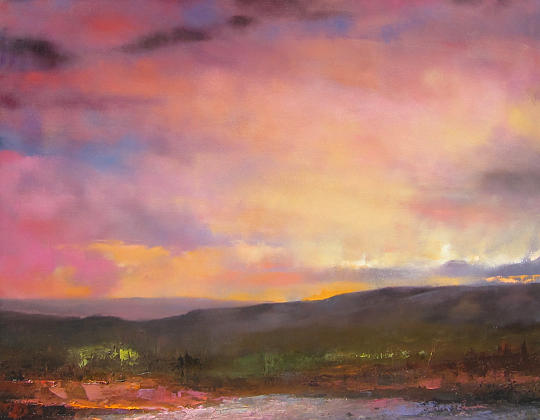The Dramatic Effect of the Horizon Line (and what happens when it’s not there…)
| Claude Monet "Water Lilies" (Source: Wiki Commons) |
During a visit to Paris last September, I spent several hours at the Orangerie museum. That’s where Monet’s amazing water lilies mural paintings are displayed. There are four walls of murals, which were painted on canvas and then affixed to curved walls. Each mural is 41 feet long and more than six feet tall. The visitor is invited to sit and contemplate these tranquil images, designed to “offer an asylum of peaceful meditation at the center of a flowery aquarium.”
What I noticed is that these paintings seem to pull the viewer in, to embrace you in such a way that you feel as if you are right on top of the pond, and almost inside it. I wondered whether the lack of a horizon contributed to this sense of no spatial limitations.
Some of the artists here at Wilde Meyer have created that sense of being pulled into their painting by omitting a horizon, or by placing it in a particular way.
Robert Charon’s “Koi Pond II” evokes the same feeling to me as Monet’s water lilies. I’m drawn into the pond, as he creates a wonderful illusion of depth, with the dark outlined stones at the bottom, the bubbles on the surface and the koi floating through them. This painting calls for reflection, too.
 |
| Koi Pond II mixed media on panel with resin varnish 24"x36" by Robert Charon |
In some of his other work, Robert creates a different mood by changing his horizon line.
 | |
| Sunset II acrylic on panel with resin varnish 12"x16" by Robert Charon |
“Since the horizon line gives the viewer a focal point, its placement depends on the subject matter,” he said. “In ‘Sunset II,’ the horizon is low, since I wanted the majority of the painting to be the sky. By showing the sunset as the lightest hue near the horizon line, and painting deeper hues above it, I can create the glow of the sunset.”
 |
| Through the Reeds acrylic on panel with resin varnish 12"x36" by Robert Charon |
 |
| Mini Distant Trees 6" x 6" by Robert Charon |
A small piece, called “Mini Distant Trees” also is interesting. The horizon line is almost in the middle, indicated by small trees. The pale sky takes your eye back, but the swath of red in the foreground is arresting. It’s a soothing painting, and yet, it’s not.
Robert Anderson, another Wilde Meyer artist, also changes his intentions, between abstract and landscape paintings. In his large work entitled “Floating in Time,” as well as “Clarity, Movement and Light,” Robert wants to “draw viewers into the painting, and keep them there.”
 |
| Floating in Time oil on canvas 96" x 72" by Robert Anderson |
 |
| Clarity, Movement, and Light oil on panel 24.5" x 24.5" by Robert Anderson |
When he’s doing landscapes, he favors a high horizon line, since he is interested in showing distance.
“With a high horizon, I can create a more dramatic vista,” he said. “The deep foreground gives me more space to show the relationship between the flowers and plants I’m focusing on, and the trees and mountains in the far distance.”
 |
| Summer Sunflowers oil on panel 33.5" x 31" by Robert Anderson |
You can see an example of Robert Anderson’s technique in “Summer Sunflowers.” The large flowers in the foreground seem even larger when contrasted with the receding background, with its much smaller flowers and trees. The intensity of the flowers’ hues also brings them forward to us, while the small line of sky seems to blend in with the soft shades of the background.
“Summer Blue,” a large 46”X66” painting, is another work with just a sliver of a horizon line at the very top of the painting. It’s quite faint, but it still helps to give the viewer the illusion of depth. Robert’s interest is obviously the field of flowers, but it wouldn’t be nearly as effective if he didn’t include the small trees and hills behind them and the little strip of pale blue sky.
 |
| Summer Blue oil on panel 46" x 66" by Robert Anderson |
 |
| Landscape 618 oil on canvas 30"x40" by Albert Scharf |
So you see, the painterly intent of the artist is often tied into the placement of the horizon line and can really elicit certain emotional reactions to a work. What do you prefer? Let us know in the comments.






































